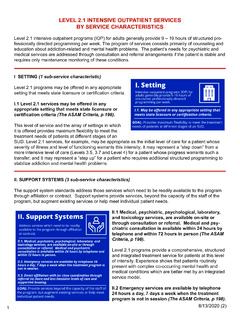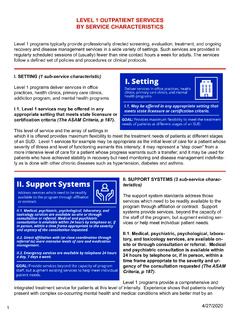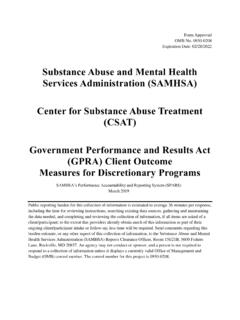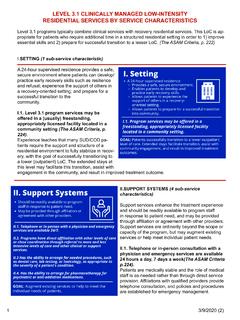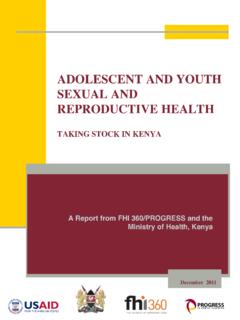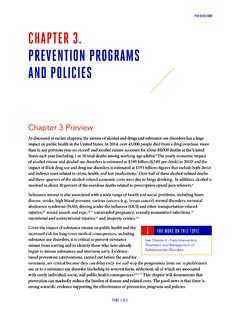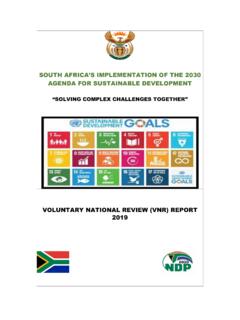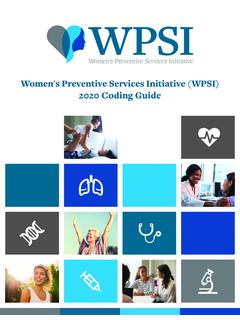Transcription of LEVEL 3.7 MEDICALLY MONITORED INTENSIVE INPATIENT …
1 LEVEL MEDICALLY MONITORED INTENSIVE INPATIENT SERVICES BY SERVICE CHARACTERISTICS SELF ASSESSMENT CHECKLISTI. SETTING (1 sub-service characteristic)I. LEVEL program services may be offered in a (usually) freestanding, appropriately licensed facility located in a community setting or in a specialty unit in a general or psychiatric hos-pital or other licensed healthcare facility (The ASAM Criteria, p. 266).The organization implements written procedures that address the handling of items brought into the program, including: Illegal substances Legal medication Prescription medication Weapons Tobacco products Gambling paraphernalia PornographyThe program implements procedures that reasonably ensure the safety of patients and staff, including but not limited to Searches of persons served, of belongings, and of the physical facility.
2 Searches will be done to preserve privacy and dignity, and will be sensitive to potential trauma of persons served. Communications, including mail, telephone use, and use of personal electronics. Visitation. Emergency program has written procedures that address conditions when a patient would physically leave the facility ( , for a doctor s appointment) and how 1:1 supervision in these circumstances is of a written policy or criteria for program entry/admission, transition, and exit. Patient- centered variable length of stay. Admission criteria include ASAM dimensional criteria as well as DSM of a 24-hour staff schedule that includes weekends and of a written daily schedule of activities that includes weekends and SUPPORT SYSTEMS (4 sub-service characteristics) Physician monitoring, nursing care, and observation are available.
3 A physician is available to assess the patient in person within 24 hours of admission and thereafter as MEDICALLY necessary (In states where physician assistants or nurse practitioners are licensed to provide such services, they may perform the duties designated here for a physician).17/7/2020 (4)A registered nurse conducts an alcohol or other drug-focused nursing assessment at the time of admission. An appropriately credentialed and licensed nurse is responsible for monitoring the patient s progress and for medication administra-tion (The ASAM Criteria, p. 266).There are written procedures that a nursing assess-ment is conducted by a Registered Nurse at ad-mission and written procedures for ongoing nursing monitoring 24 hours/day, 7 are written procedures for onsite or on-call availability of medical personnel ( , physician, or nurse practitioner or physician assistant in states where they may perform physician duties)
4 To conduct medical assessments within 24 hours of admission and to respond to urgent medical or psychiatric situa-tions 24 hours/day, 7 the medical personnel are not onsite, there is a current written agreement that details the contract-ed providers responsibilities and are written procedures instructing staff on when and how to access on-call medical personnel or to use of a 24 hours/day, 7 days/week nursing schedule and credentials of the staff in the of nursing and medical assessments in the patient Additional medical specialty consultation, and psychological, laboratory, and toxicology services, are available on-site, through consulta-tion or referral (The ASAM Criteria, p. 267).Documentation of written relationships/agreements (contract, MOU, etc.) with medical specialty, labo-ratory/drug testing, psychological, and pharmacy services.
5 The agreements are specific about what is expected of each provider as well as expectations for ongoing partnership in treatment planning, collabora-tive monitoring, and program has written procedures describing the utilization of and referral process for: Specialty medical services. Pharmacy services. Lab services. 2 7/7/2020 (4)3 Drug testing. Psychological policy that identifies the process for patients to obtain medications when needed, including safe ASAM LEVEL programs have the ability to provide coordination of necessary services, or other levels of care are available through direct affiliation or referral processes (such as step-down services for continuing care and/or medical follow-up services) (The ASAM Criteria, p. 267).The program has written procedures for: Referral, including: -Referral to other services, when applicable.
6 -Coordination when a patient is concurrently being served in another LEVEL of care ( , Opioid Treatment Services). Transfer, including: -Identifying when transition planning will occur. -Identifying where transition planning summary is documented. -Documented and reviewing the six ASAM Criteria dimensions as it relates to transfer and consistent with chronic disease management. Inactive status, if program has written procedures for how it coordinates with providers delivering concurrent care ( , when a patient is also receiving Opioid Treatment Services).Program has written procedures for how it follows-up with the patient and post-transfer or referral source to ensure engagement in the next LEVEL of care ( , procedures to secure patient consent to engage with follow-up providers).
7 Documentation that the program has a network of affiliations to meet the needs of patients when they transfer to another LEVEL of program has written procedures for unplanned discharges ( , when the patient chooses to abruptly leave the program and transition planning is not possible), including timely follow-up and necessary Psychiatric services are available on-site, through consultation or referral, when a presenting issue could be attended to at a later time. Such services are available within eight (8) hours by telephone or 24 hours in person (The ASAM Criteria, p. 267).There are written procedures for onsite or on-call availability of psychiatric services including responding by phone within 8 hours, or in-person within 24 hours and sooner, if clinically psychiatric services are unavailable onsite, there is a current written agreement that details the contracted providers responsibilities for telephone and in-person procedures for handling a psychiatric emergency, including an affiliation agreement with a LEVEL 4 program for patient (4)III.
8 STAFF (3 sub-service characteristics) An interdisciplinary staff (including physicians, nurses, addiction counselors, and behavioral health specialists) who are able to assess and treat the patient and to obtain and interpret infor-mation regarding the patient s psychiatric and substance use or addictive disorders (The ASAM Criteria, p. 268).Program has a written policy and procedures on clinical staff responsibility for treatment plan has a written policy on credentials of clinical has a written job description and qualifications for the program Clinical staff knowledgeable about the biological and psychosocial dimensions of addiction and other behavioral health disorders, and with specialized training techniques and evidence-based practices. The staff is able to provide a planned regimen of 24-hour, profes-sionally directed evaluation, care, and treatment services (including administration of prescribed medications) (The ASAM Criteria, p.)
9 268).Evidence of a 24 hours/day, 7 days/week sched-ule of professionally directed evaluation, care, and treatment, including staff of medication administration A licensed physician to oversee the treatment process and assure the quality of care. Physicians perform physical examinations for all patients admitted to this LEVEL of care. Many states require that the physician serving as medical director for a LEVEL treatment program be a certified addiction medicine physician or addiction psychiatrist. These physicians have specialty training and/or experience in addiction medicine or addiction psychiatry and, if treating adolescents, experience with adolescent patients in this LEVEL of care receive addiction pharmacotherapy, integrated with psycho-social therapies. The provider of such care can be a physician assistant or other licensed inde-pendent practitioner with prescribing authority who is knowledgeable about addiction treatment, especially pharmacotherapies (The ASAM Criteria, p.
10 268). Position description for the medical of the credentials of the medical director and other physicians working under the medical director s (4)Evidence that the medical director develops written treatment protocols. Credentials of clinicians prescribing THERAPIES (10 sub-service characteristics) Daily clinical services (provided by an interdisciplinary treatment team) to assess and ad-dress the patient s individual needs. Clinical services may involve appropriate medical and nurs-ing services and individual, group, family, and activity services (The ASAM Criteria, p. 269).Evidence of a daily schedule of activities that includes medical, nursing, and other clinical of a staff schedule documenting interdisciplinary involvement in activities. Evidence of a program description describing services and objectives of Planned clinical program activities to stabilize the acute addictive and/or psychiatric symptoms.

